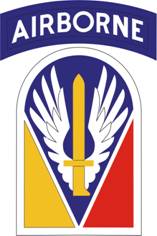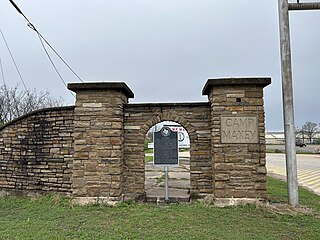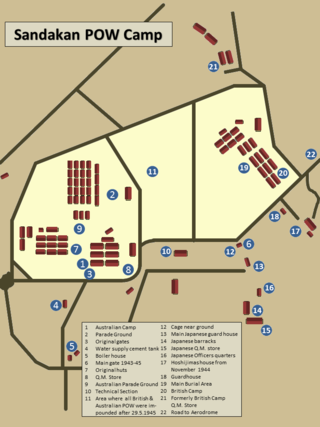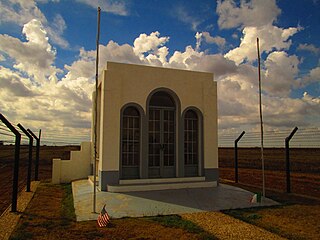
The 36th Infantry Division ("Arrowhead") also known as the "Panther Division", the "Lone Star Division", "The Texas Army", and the "T-patchers", is an infantry division of the U.S. Army and part of the Texas Army National Guard. The 36th Infantry Division was organized during World War I (1914–1918) from units of the Texas National Guard and of the Oklahoma National Guard. As an all-Texas unit, the Arrowhead Division was called to service for World War II (1937–1945) on 25 November 1940, was deployed to the European Theater of Operations in April 1943, and returned to the Texas Army National Guard in December 1945.
Camp Perry is a National Guard training facility located on the shore of Lake Erie in northern Ohio near Port Clinton. In addition to its regular mission as a military training base, Camp Perry also boasts the second largest outdoor rifle range in the world after the NRA Whittington Center in Raton, New Mexico. The firing is done in the direction of the open water of the lake, that lies just beyond an earthen berm and the targets.

Fort D. A. Russell is the name of an American military installation near Marfa, Texas, that was active from 1911 to 1946. It is named for David Allen Russell, a Civil War general killed at the Battle of Opequon, September 19, 1864.

Fort Johnson, formerly Fort Polk, is a United States Army installation located in Vernon Parish, Louisiana, about 10 miles (15 km) east of Leesville and 30 miles (50 km) north of DeRidder in Beauregard Parish.

Fort McClellan, originally Camp McClellan, is a decommissioned United States Army post located adjacent to the city of Anniston, Alabama. During World War II, it was one of the largest U.S. Army installations, training an estimated half-million troops. After the war it became the home of the Military Police Corps, the Chemical Corps and the Women's Army Corps. From 1975 and until it was closed in 1999, Fort McClellan was home of the Military Police Corps and the One Station Unit Training (OSUT) Military Police School. Also after World War II and until it was closed in 1999, it was home of the Chemical Corps School, which trained soldiers in chemical warfare. In 1988, Fort McClellan was used as an alternate training academy for the United States Border Patrol. Before its closure by the Base Realignment and Closure commission (BRAC), the post employed about 10,000 military personnel and about 1,500 civilians. It underwent unexploded ordnance (UXO) clean up from 2003 to 2014. Since 2010, about 3,000 acres of the post's brownfield land have been redeveloped as a mixed-use community. The portion of the post which has not been redeveloped is currently owned by the Alabama Army National Guard and is used as a training facility for units from all across the state, also housing the Alabama Army National Guard’s Officer Candidate School, for enlisted soldiers looking to earn their commission.

Camp Blanding Joint Training Center is the primary military reservation and training base for the Florida National Guard, both the Florida Army National Guard and certain nonflying activities of the Florida Air National Guard. The installation is located in Clay County, Florida, near the city of Starke in adjacent Bradford County. However, while Camp Blanding utilizes a Starke address, it is located totally within the confines of Clay County. The site measures about 73,000 acres (30,000 ha) and includes Kingsley Lake. It also hosts other Reserve, Army National Guard, Air National Guard, and some Active Component training for the U.S. Armed Forces.

Camp Atterbury-Muscatatuck is a federally owned military post, licensed to and operated by the Indiana National Guard, located in south-central Indiana, 4 miles (6.4 km) west of Edinburgh, Indiana and U.S. Route 31. The camp's mission is to provide full logistical and training support for up to two brigade-sized elements simultaneously. The Camp offers a variety of training ranges, live-fire venues, managed airspace with air-to-ground fighting capabilities and an LVC simulation and exercise center. It is also the normal Annual Training location for National Guard and Reserve forces located in Indiana.
Camp Ellis was a United States World War II Army Service Forces Unit Training Center and prisoner-of-war camp between the towns of Bernadotte, Ipava, and Table Grove in Fulton County, Illinois. Construction began on 17 September 1942, and the camp opened on 16 April 1943, with an official dedication 14 July 1943. German prisoners of war were guarded by the 475th and 476th Military Police Escort Guard Companies. Training activities ended in November 1944.

Camp Bullis Military Training Reservation is a U.S. Army training camp comprising 27,990 acres (113.3 km2) in Bexar County, Texas, USA, just northwest of San Antonio. Camp Bullis provides base operations support and training support to Joint Base San Antonio. The camp is named for Brigadier General John L. Bullis.

Camp Adair was a United States Army division training facility established north of Corvallis, Oregon, operating from 1942 to 1946. During its peak period of use, the camp was home to approximately 40,000 persons — enough to have constituted the second largest city in the state of Oregon. The camp was largely scrapped as government surplus following termination of World War II, with a portion of the site reconstituted as "Adair Air Force Station" in 1957.

The 116th Air Refueling Squadron is a unit of the Washington Air National Guard 141st Air Refueling Wing located at Fairchild Air Force Base, Spokane, Washington. The 116th is equipped with the KC-135R Stratotanker and RC-26B Metroliner.

Camp Edwards is a United States military training installation located in western Cape Cod in Barnstable County, Massachusetts. It was named after Major General Clarence Edwards, commander of the 26th Division in World War I. The base is currently the home of portions of the 3rd Battalion, 126th Aviation Regiment, of the Massachusetts Army National Guard.

Camp Maxey is a Texas Military Department training facility that was originally built as a U.S. Army infantry-training camp during World War II. It was occupied from July 1942 to early 1946, and located near the community of Powderly, Texas in the north central portion of Lamar County, Texas. Its main entrance was located nine miles north of Paris, Texas. Planning for the 70,000-acre military post began in 1940, soon after the National Military Draft was ordered; the planning accelerated in 1941 shortly before the United States entered World War II in December 1941.

Camp Gruber is an Oklahoma Army National Guard (OKARNG) training facility. It covers a total of 87 square miles (230 km2).
Camp Hulen was a military training camp near Palacios, Texas, United States that operated from 1925 until 1946, and at one time supported the largest concentration of troops for field training in the United States military.

The history of the Arkansas National Guard and World War II begins with the reorganization following World War I. The State first reorganized a provision unit, the 5th Arkansas, in order to provide a force to deal with domestic situations. As the Defense Department slowly implemented the massive changes and expansions outlined National Defense Act of 1916, the Arkansas National Guard was allowed to reorganize its war time units, including the 153rd Infantry Regiment, the 141st Machine Gun Battalion, and the 142nd Field Artillery. The Guard acquired its first permanent facilities and additional training during its annual encampments. During World War II, the entire Arkansas National Guard was activated and units saw duty in the Pacific and European theaters of conflict.

The Sandakan camp, also known as Sandakan POW Camp, was a prisoner-of-war camp established during World War II by the Japanese in Sandakan in the Malaysian state of Sabah. This site has gained notoriety as the Sandakan Death Marches started from here. Now, part of the former site houses the Sandakan Memorial Park.

The 144th Infantry Regiment is an infantry regiment of the United States Army, Texas Army National Guard. It was formed in 1880 and served in several American wars including the present War on Terror. Currently, only the 3rd Battalion remains, and it is a part of the 56th Infantry Brigade Combat Team of the 36th Infantry Division.
DeWitt General Hospital was a World War II US Army Hospital in Auburn, California, in Placer County at the corner of C Avenue and First Street. The hospital was built in 1944 to care for troops returning home from overseas service and troops that served on the home front. The first patient checked in on February 17, 1944. The hospital had 2,285 beds housed in single story buildings over the 284 acres campus. DeWitt General Hospital was three miles north of downtown Auburn.

Camp Hereford, the Hereford Internment Camp, or the Hereford Military Reservation and Reception Center was an American prisoner-of-war camp that housed Italian prisoners during World War II. The camp was located about 3 miles (4.83 km) south of Hereford, Texas, and was the second largest prisoner-of-war camp in the United States, capable of housing nearly 6,000 prisoners as well as 750 American military personnel. It was constructed in 1942 and began housing inmates in 1943. By February 1946 all prisoners of war had been repatriated and the camp was placed on the surplus list.


















